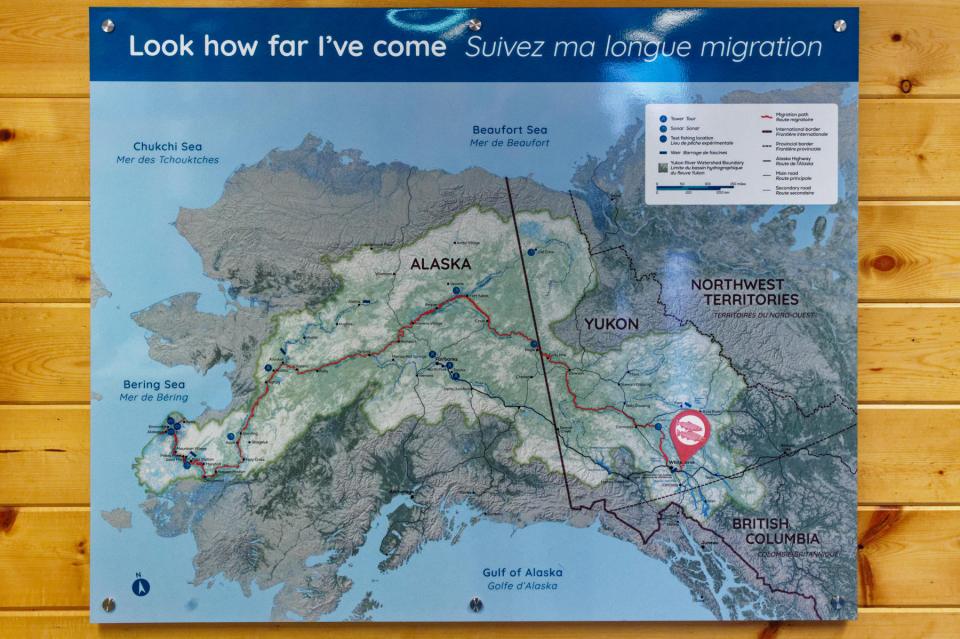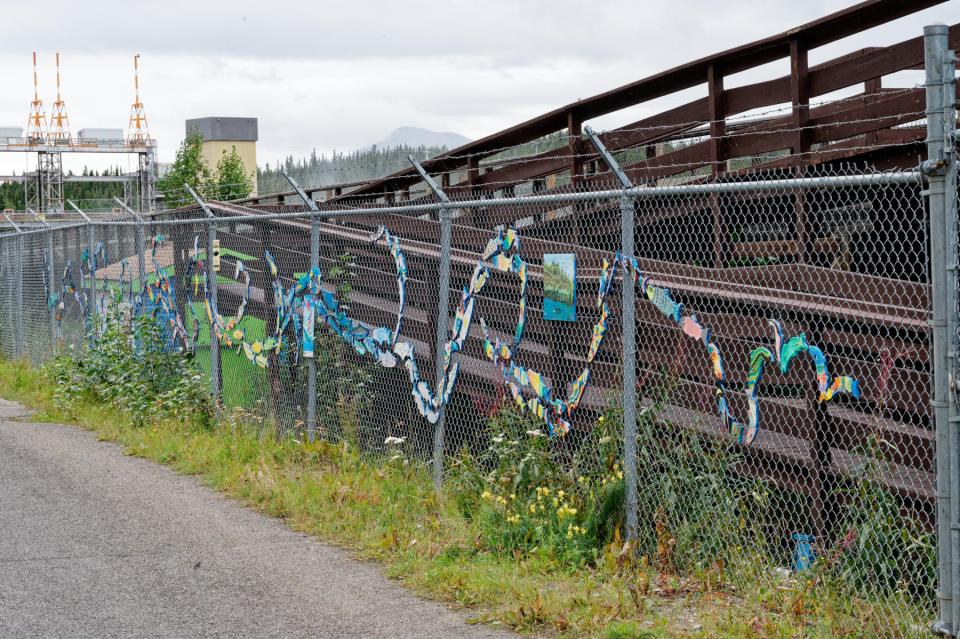Sunday 28 August 2022 – Despite my best efforts, I couldn’t stay asleep much beyond 8am, and soon it became clear that the same was true for Jane. Since the weather forecast was for a morning with some sunny intervals and an afternoon with cloud, we decided to go for a walk around Whitehorse to explore it beyond the rather superficial introduction we’d had from Bernie’s city tour.
One can tell, by the way, that it’s summer here from the amount of road construction work that is under way. Bernie explained that Whitehorse has four seasons: nearly winter; winter; still winter; and road construction. So it was nice to be able to stroll stroll around on a summer’s day.
Obviously, Whitehorse has a significant historical, erm, significance, from the part it had to play in the good ol’ days of the gold rush. It is, however, a fairly low-key town; not large, and possible to drive through and dismiss as dull. If you walk around on a quiet, sunny Sunday morning, however, the place has considerable charm. There’s plenty to enjoy and some things to learn, also.
There are plenty of log buildings, some historical, some more modern. One of the tourist attractions which I mentioned yesterday is the Log Skyscraper, built in 1947 by one Martin Berrigan. A massive influx of military personnel and labourers arrived to work on three major construction projects – the Alaska Highway, the North West Staging Route airports, and the Canol Pipeline – during the post-war boom; housing was at a premium (as it still is today). So Berrigan, having started by building one-storey log cabins, decided it would be more effective to build up; and the log skyscraper was born.

There are, as I say, other log buildings: a church and rectory;

a cluster of three relatively modern log buildings now used for businesses;

and many historical ones. One, the original telegraph office, is the oldest building still in its original location, and has been subsumed into the James McBride museum;

and others can be found at Shipyards Park.


There are plenty of historical timber buildings, too, such as the old fire station

and, of course, the railway station marking the end of the White Pass and Yukon route, which linked Whitehorse and Skagway from late in the 19th century. The railway only runs these days to White Pass (you will remember that we rode this route from Skagway, because you have been paying attention, haven’t you?), but the original rails are still largely in place in Whitehorse as a historical and cultural landmark.

There’s a healthy selection of murals



and statues, some quirky

and some more serious, like this memorial to workers who have been killed;

and many First Nation references and installations.




There’s evidence of a burden of guilt about the original treatment by the settlers of the indigenous peoples (which was at times appalling), along with what seems to be a genuine desire to balance this through recognition and inclusion.
In keeping with many places we’ve been to in what counts to us as the far north (Alaska, Iceland), there are many colourful and quirky touches



alongside some attractive buildings


and some evidence of housebuilding to attempt to catch up with demand for housing.

On the southern edge of the downtown area is the S.S. Klondike, the second of two sternwheelers carrying the name and now a National Historic Site. They ran freight between Whitehorse and Dawson City, along the Yukon River, the first from 1929 to 1936 and the second, an almost exact replica of the first, from 1937 to 1950.

Nearby that is a park which has a delightful kids’ splash park.

There are several fountains which operate in a cycle once a button is pressed. I was particularly taken with a bucket fill-and-tip installation

and a “ring of water”.

Whitehorse is a small town, but, alongside its significant role in governing the territory, it has some very charming corners.
In the evening, we went for a repeat visit to yesterday’s aurora viewing site. It was interesting that the lights had already started by the time we got there at about 11pm, in contrast to the day before, when we had to wait 90 minutes for the show to start. This show was better for spectators – it covered large parts of the sky and was brighter than the previous one – but in a way less good for photography, because there was less variety in the colours on display. Nonetheless, we got a few images which we think are pretty pleasing.


This one is Jane’s favourite – a whiskery troll’s howling face in the sky.

Thus ended the second aurora session and, once again, we got our heads down at about 3.30am with a hope for some semblance of sleep before we had to get up and check out. It was our last full day in Whitehorse; we head back to Vancouver tomorrow afternoon for the chance to draw breath before embarking on the next section of this trip. We look forward to exploring Vancouver in some more detail, so please keep checking in to see what we got up to there.




























 and – my favourite – a lynx. I wouldn’t have spotted it, but Jane did and between us we managed to get a very satisfactory image even though it was quite distant. My mobile phone did a great job, here.
and – my favourite – a lynx. I wouldn’t have spotted it, but Jane did and between us we managed to get a very satisfactory image even though it was quite distant. My mobile phone did a great job, here.






























